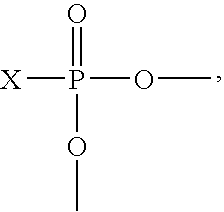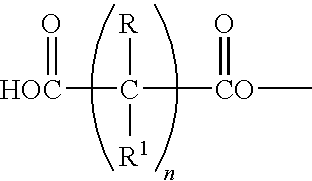Electrocoat composition and process replacing phosphate pretreatment
a technology of electrocoat and composition, applied in the direction of peptides, liquid/fluent solid measurements, fluid pressure measurements, etc., can solve the problems of large paint system (“paint shops”) in automotive assembly plants, complex, and expensive, and achieve strong corrosion resistance, enhance the anticorrosion effect of metal oxide, and resist corrosion
- Summary
- Abstract
- Description
- Claims
- Application Information
AI Technical Summary
Benefits of technology
Problems solved by technology
Method used
Image
Examples
examples
Preparation A
Preparation of the Phosphorylated Epoxy Resin
[0115]A reactor equipped with an agitator and reflux condenser is charged with 25.85 parts by weight of normal butanol, 10.20 parts by weight of ethylene glycol monobutyl ether, and 55.62 parts by weight of the diglycidyl ether of Bisphenol A. The reactor contents are stirred for about 15 minutes followed by addition of 4.261 parts by weight of phosphoric acid (75% aqueous) and 1.77 parts by weight normal butanol. The resulting mixture is stirred at room temperature for an additional 15 minutes then heated to 102.2° F. (49° C.). The heat is turned off and the mixture is allowed to exotherm, recorded as 260.6° F. (127° C.). The reaction mixture is cooled to 220-250° F. (104.4-121.1° C.) and held for 2 hours, at which time the weight per epoxide of the product is 20,000 or greater. Deionized water is added in a first portion of 0.899 parts by weight, and the reaction mixture is maintained at 220-250° F. (104.4-121.1° C.) for on...
preparation b
Preparation of the Phosphorylated Epoxy Resin Carboxylated with Dodecenylsuccinic Anhydride (DDSA)
[0116]A reactor equipped with an agitator and reflux condenser is charged with 25.85 parts by weight of normal butanol, 10.20 parts by weight of ethylene glycol monobutyl ether, and 55.62 parts by weight of the diglycidyl ether of Bisphenol A. The reactor contents are stirred for about 15 minutes followed by addition of 4.261 parts by weight of phosphoric acid (75% aqueous) and 1.77 parts by weight normal butanol. The resulting mixture is stirred at room temperature for an additional 15 minutes then heated to 102.2° F. (49° C.). The heat is turned off and the mixture is allowed to exotherm, recorded as 260.6° F. (127° C.). The reaction mixture is cooled to 220-250° F. (104.4-121.1° C.) and held for 2 hours at which time the weight per epoxide of the product is 20,000 or greater. Deionized water is added in a first portion of 0.899 parts by weight, and the reaction mixture is maintained ...
preparation d
Preparation of Binder Emulsion with the Carboxylated Phosphorylated Epoxy Resin
[0120]The following materials are combined in a 3-L flask with an associated heating mantle: diglycidyl ether of bisphenol A (DGEBA), (18.03 parts), bisphenol A (BPA), (4.1 parts), phenol (1.41 parts), and propylene glycol n-butyl ether (0.36 parts).
[0121]While stirring, the temperature is raised to 257° F. (125° C.). Subsequently, triphenylphosphine (0.04 parts) is added and the exotherm is recorded as 392° F. (200° C.). The mixture is then allowed to cool to 275° F. (135° C.), and a weight per epoxide (WPE) determination (target=525+ / −25) is conducted after 1 hour and is 524. After cooling to 194° F. (90° C.) and turning off the heating mantle, 2.36 parts of PLURACOL® 710R (sold by BASF Corporation) is added, then 1.73 parts of diethanolamine is introduced and the exotherm is recorded as 237.2° F. (114° C.). The reaction mixture is allowed to stir for an additional 30 minutes at 221° F. (105° C.) after ...
PUM
| Property | Measurement | Unit |
|---|---|---|
| Percent by mass | aaaaa | aaaaa |
| Weight | aaaaa | aaaaa |
| Electrical conductivity | aaaaa | aaaaa |
Abstract
Description
Claims
Application Information
 Login to View More
Login to View More - R&D
- Intellectual Property
- Life Sciences
- Materials
- Tech Scout
- Unparalleled Data Quality
- Higher Quality Content
- 60% Fewer Hallucinations
Browse by: Latest US Patents, China's latest patents, Technical Efficacy Thesaurus, Application Domain, Technology Topic, Popular Technical Reports.
© 2025 PatSnap. All rights reserved.Legal|Privacy policy|Modern Slavery Act Transparency Statement|Sitemap|About US| Contact US: help@patsnap.com



